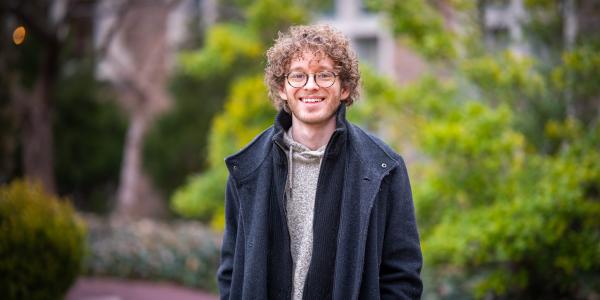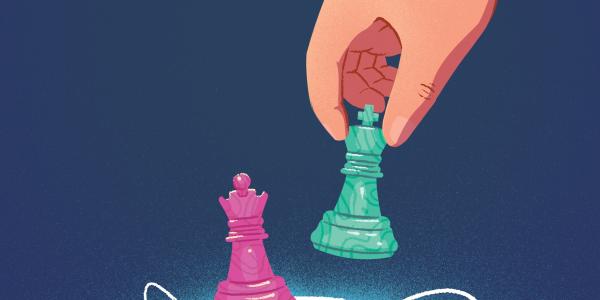A new WashU program, A&S CREATES, is helping students like Moore share their work beyond traditional audiences.
Matthew Moore, a doctoral candidate in the Department of English, has a dilemma: The people he writes about are unlikely to read his work.
Moore is a first-generation college student from Blythedale, Missouri, a blue-collar town with fewer than 200 residents. “A college education was unattainable for most there and scorned by the rest,” said Moore, who earned an MFA from Iowa State University. Growing up in rural Missouri sparked his academic interest in whiteness, masculinity, and working-class culture in the heartland. The more he explored these themes in his writing, however, the more distant he felt from the communities they represented.

A new WashU program for graduate students, A&S CREATES, is helping bridge that divide. The program’s first cohort is focused on public scholarship, encouraging students like Moore to share their work beyond traditional academic audiences. Developed by William Acree, vice dean of interdisciplinary initiatives and innovation, A&S CREATES has changed Moore’s approach to public-facing writing and helped him pen his first essay for Belt Magazine.
Why did you want to join the A&S CREATES program and the cohort on public scholarship?
I wanted to be at the forefront of this new initiative because I've always valued interdisciplinary scholarship and collaboration. I liked that the program would put me outside my comfort zone and allow me to work with graduate students from other departments. I’ve also come to think about how my work — somewhat insular academic writing — can have a wider impact and engage directly with the communities I’m writing about. I view art as a social practice, an active engagement with the world that serves as a form of advocacy. This program is a continuation of that and a segue into how I’m approaching my public-facing work.
What has the program been like so far?
The cohort — which includes graduate students in anthropology, Earth sciences, archaeology, and French — meets once a week for a seminar-style course taught by Christopher Schaberg, WashU’s director of public scholarship. He’s shared how to write polished magazine pitches, create easily accessible websites, and craft book proposals for different audiences. We also have conversations about why it’s important to do this work and how Arts & Sciences students can have a broader impact on society.
You recently had a piece published in Belt Magazine, a non-academic journal. How did this program help you pitch and write that essay?
Every student wrote a pitch for The Conversation, a nonprofit news site that publishes stories with expert analysis by university-based scholars. My pitch was rejected, but it still provided a valuable lesson, and I received great feedback on how to pitch the next time. Chris helped me transform an original, small idea — my dad’s frustration with me running out of gas in rural Missouri — into my next pitch, a look at the politics of mobility in rural America and its reliance on a fossil-fuel-driven economy. It was accepted and published in Belt Magazine, a publication that focuses on the Rust Belt and the greater Midwest. The experience made me realize there’s no wasted work.
“I view art as a social practice, an active engagement with the
world that serves as a form of advocacy.”

front of his family’s old Dodge truck. Moore grew up in rural Missouri,
an experience he explored in an essay for Belt Magazine. (Photo
courtesy of Matthew Moore)
The Belt essay is quite personal and discusses your relationship with your dad. What feedback have you received from friends and family?
Many of the people who influenced me early in life likely wouldn’t read my work, as it’s still very much a product of academia. But the Belt essay circulated on Facebook, so my dad and a lot of my extended family saw it and liked it. Friends back home read the story and many of them messaged me expressing how much it resonated with them. Even people I didn't grow up with, but who grew up in a similar place, reached out to say how much they related to the piece. Seeing the story have a wide impact was really significant to me because these are not only the people I'm writing about, but also the people I'm trying to write for.
Do you have plans to continue with this public-facing work?
I plan to write more pitches and, hopefully, another essay by the end of the semester. I’m now confident that I can take small ideas, theories, or even brief moments from a paper or poem and craft a piece within the context of contemporary culture or politics for a widely read platform like Slate. That’s the mindset Chris instilled in our cohort. A&S CREATES has been invigorating for those of us who find our academic pursuits to be narrow or even antiquated. Public-facing scholarship makes you realize that’s not the case.
This story appeared in the Spring 2025 issue of Ampersand magazine. See more stories from the magazine and browse our archives.





